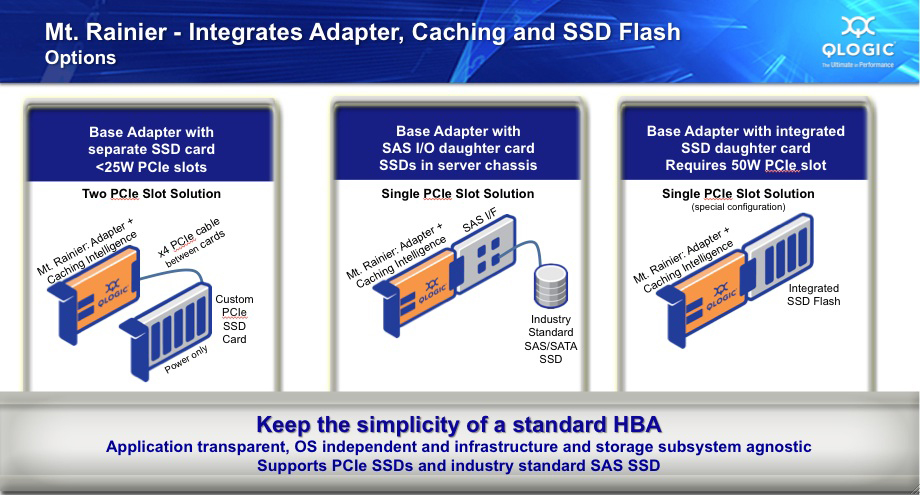QLogic announced a new technology project called Mt.Rainier,which combines its I/O adapter cards with industry standard NAND flash storage to bring server-based SSD caching performance to the SAN.
The Mt.Rainier host bus adapter card will enable sharing of SSDs in multiple servers to create a transparent,shared cache.The release time for the new HBAs is early 2013.
Mt.Rainier-connected SSDs can also be configured to create a single pool of high-performance storage inside clustered servers that can be allocated for various multi-server applications,while retaining the benefits of managed SAN storage.
The Mt.Rainier adapter card allows users to connect different SSDs,including PCIe flash-based storage cards and industry standard SAS SSDs,together as a shared pool of high-performance flash cache.
Data caches can also be mirrored between two Mt.Rainier server adapter cards in a cluster for high availability and greater performance with write-back caching.
Like EMC's project Lightning,which was built around offering PCIe flash cards for servers,QLogic said its Mt.Rainier product is only the beginning of its strategy to incorporate NAND flash storage in its product offerings.EMC followed project Lightning PCIe cards with Project Thunder,an all-flash appliance.
Chris Humphrey,vice president of corporate marketing at QLogic,said that while SSDs and PCIe flash cards in storage arrays offer a high-performance"tier 0"capability,if a single SSD storage volume is being shared by multiple business units,it creates an I/O bottleneck as well as latency issues.Server-based SSDs are not shared across a cluster.
"The distance from the SAN to the server processor means latency.It's a limitation of storage array controllers in the SAN.And,with server-side SSDs today,it's really direct-attached storage...it requires more[software]drivers,more complexity and more dependencies,"he said."So,if you can take those server SSDs and bring them into the SANs,you're able to use them as shared resources."
Mt.Rainier uses only one lightweight QLogic software driver,which Humphrey said simplifies installation and management,particularly for servers running multiple virtual machines and clustered applications.
There are three configurations for the Mt.Rainier cards:
An adapter with separate SSD card for 25W PCIe cards.A base adapter with the caching software along with a SAS I/O daughter card for SSDs in server chassis A base adapter card with an SSD daughter card that can be used for 50W PCIe cards.The third configuration will only be sold to server manufacturers

The three configurations for the Mt.Rainier server SSD adapter card.
Jeff Boles,a senior analyst at market research firm Taneja Group,said storage performance is one of the most pervasive challenges in the data center,and compute power has leaped past the ability of SAN storage to keep up.
"QLogic's Mt.Rainier defines a new technology category we call'server-based storage accelerators,'in which HBAs cache SAN data on server-based SSD storage in a transparent,shared architecture,"he said."Mt.Rainier could well become the de facto choice for solving I/O challenges in every data center."





